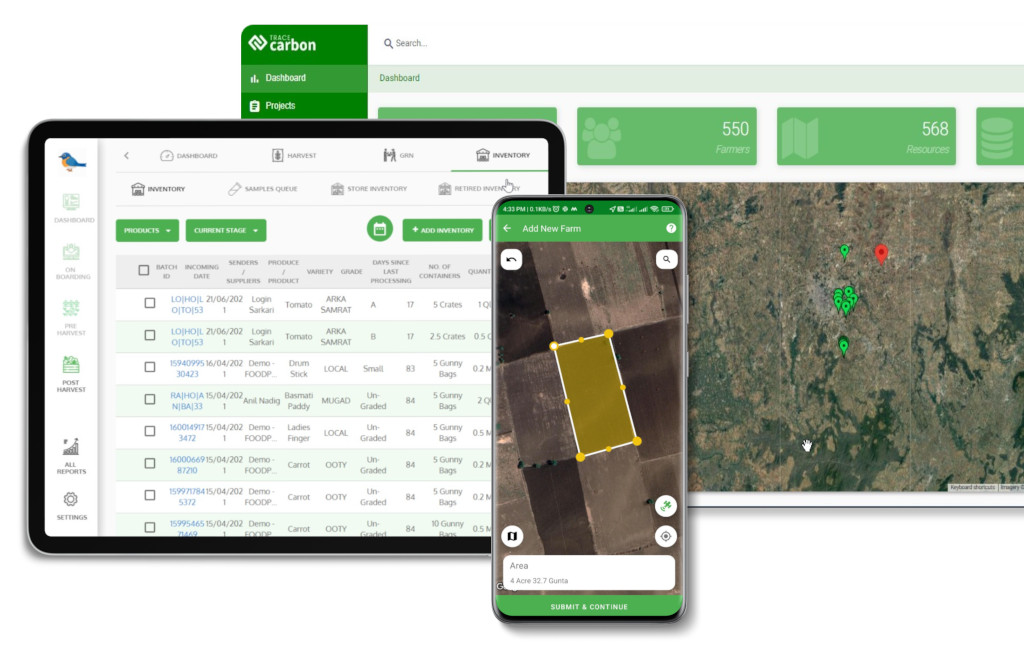Contact: +91 99725 24322 |
Menu
Menu
Quick summary: TraceX helps cocoa companies in Netherlands meet EUDR requirements with automated Due Diligence Statement (DDS) generation, farm-level traceability, and deforestation risk verification.

EUDR DDS for Cocoa Supply Chain in the Netherlands refers to the compliance process under the EU Deforestation Regulation (EU 2023/1115), requiring all cocoa imported, processed, or traded through the Netherlands to be deforestation-free and legally produced. As one of Europe’s largest cocoa import and processing hubs, Dutch companies must submit a Due Diligence Statement (DDS) with verified farm-level geolocation data and legality proof by December 30, 2025. Implementing digital traceability platforms enables importers, processors, and traders to automate DDS workflows, verify supplier data, and maintain transparent, compliant cocoa value chains across global sourcing regions.
The EU Deforestation Regulation makes it illegal to place cocoa (beans and derivatives like liquor, butter, cake, powder, chocolate inputs) on the EU market unless it is deforestation-free (no land-use change after 31 Dec 2020) and legally produced in the country of origin. Each consignment must be backed by a Due Diligence Statement (DDS) submitted through the EU IT system, linking the product to verified geolocations of the plots where it was grown.
The Netherlands is Europe’s largest cocoa gateway and processing hub (Amsterdam/Rotterdam ports, large grinding capacity), handling roughly 20–25% of global cocoa trade. That scale means Dutch importers, grinders, manufacturers, and traders sit at the critical control point for EUDR compliance across West Africa, Latin America, and Asia. The Netherlands is a critical player in this context.
As Europe’s largest importer of cocoa beans and derivatives, and with major ports and processing facilities located in the country, Dutch companies frequently act as the first entity to place cocoa products on the EU market. Consequently, they carry the primary compliance responsibility under the EUDR. For cocoa, this is especially significant: beans, cocoa paste, butter, powder, and chocolate are all explicitly covered under the regulation. This means that companies in any part of the cocoa supply chai,n from bean importers through to chocolate manufacturers, must ensure traceability, legality, and deforestation-free sourcing.
Master the step-by-step process of submitting Due Diligence Statements under the new EUDR rules.
Read the blog on filing DDS for EUDR compliance
Explore how cocoa importers can achieve traceability, transparency, and compliance under EUDR.
Read the full blog on EUDR Cocoa Compliance
Dutch operators source from West Africa (Côte d’Ivoire, Ghana, Cameroon), plus Latin America and Asia, each with different data standards, certification regimes, and digitization levels. Cooperatives may use basic spreadsheets; exporters may run proprietary systems; some origins rely on paper records. This patchwork creates format incompatibilities, missing fields, and limited interoperability, making end-to-end due diligence slow and error-prone.
EUDR requires plot-level coordinates (ideally polygons) for all farms in scope. In practice, many co-ops lack:
Complex DDS packets pull data from sourcing contracts, shipping docs, lab results, satellite checks, and supplier declarations. When assembled via emails, PDFs, and spreadsheets, teams face:
Cocoa moves through segregated, identity-preserved, or mass-balance models. Once beans are cleaned, graded, blended, or processed (liquor, butter, cake), maintaining the link from batch → farm polygons requires strict chain-of-custody discipline (lot re-ID, yield reconciliation, shrinkage accounting). Any gap breaks the chain back to geolocations—invalidating the DDS.
Authorities expect consistent, tamper-evident records: timestamps, user actions, and an immutable history. Inconsistent coordinates, supplier name mismatches, or non-standard file types (KML/GeoJSON/CSV) trigger queries. Lack of independent corroboration (e.g., satellite change detection) elevates risk and can stall customs clearance.
High shipment volumes through Dutch ports mean more statements, more checks, and greater odds of a spot audit. Post-grace enforcement introduces fines up to 4% of EU-wide turnover, seizure/detention, and contract fallout with EU buyers. Reputational risk is material for brands marketing “deforestation-free” chocolate.
EUDR raises the bar from “certified” to verifiably geolocated and deforestation-free. For the Netherlands, Europe’s cocoa nerve center, the challenge is scaling accurate polygons, a clean chain-of-custody, and automated DDS across thousands of smallholders and complex processing flows. Teams that industrialize these capabilities now will cut audit risk, protect market access, and turn compliance into trusted product claims and commercial advantage.
The EUDR DDS (Due Diligence Statement) requirement demands traceability from farm to port, something nearly impossible to scale manually across thousands of smallholder suppliers. TraceX EUDR Platform bridges this complexity with a unified digital ecosystem designed specifically for EUDR compliance in cocoa supply chains.
TraceX automates the generation of DDS forms by pulling verified data from supplier records, GPS-mapped farms, and sourcing transactions. Integrated directly with the EU’s information system, it enables one-click submission, eliminating manual data entry and formatting errors that typically delay compliance.
Every cocoa batch is linked to immutable blockchain records capturing its journey from the farm or cooperative to the exporter, processor, and importer. This ensures tamper-proof proof of origin, guaranteeing data integrity across transactions and building verifiable audit trails for competent authorities.
TraceX makes it easy to bring smallholder farmers and cooperatives into the digital compliance ecosystem. Using mobile apps, GPS-based field mapping, and farm registration workflows, the platform captures polygon geolocation data, farm size, and ownership details, the foundation for compliant DDS submissions.
A dynamic risk engine continuously evaluates sourcing regions using deforestation datasets, legality benchmarks, and satellite imagery. Real-time dashboards allow importers and processors to visualize supply risks, validate suppliers, and prioritize corrective actions, all before filing a DDS.
A Dutch cocoa processor using TraceX can verify beans sourced from Côte d’Ivoire and Cameroon, mapping each farm, validating supplier records, and generating compliant DDS automatically. With blockchain-backed transparency, the company can achieve full audit readiness months before the 2025 EUDR deadline.
In essence, TraceX transforms EUDR compliance from a fragmented paperwork process into a scalable, intelligent traceability system empowering cocoa traders and processors to ensure deforestation-free, transparent, and legally verified supply chains.

The Netherlands sits at the heart of Europe’s chocolate and confectionery supply chain, home to major processors and exporters supplying global brands. As consumers increasingly demand ethically sourced and deforestation-free products, verified traceability has become a key differentiator. Cocoa that can be digitally traced back to mapped farms demonstrates environmental responsibility and supply chain integrity, a vital driver of brand trust in retail and premium chocolate markets. Under EUDR, “deforestation-free” is no longer just a sustainability label; it’s a market access prerequisite.
For companies already certified under Rainforest Alliance, Fairtrade, or UTZ, EUDR compliance offers an opportunity to align existing ESG programs with regulatory expectations. TraceX’s traceability infrastructure enables data interoperability, linking certification records, geolocation data, and compliance documentation in a unified digital ledger. This reduces audit duplication and strengthens the credibility of sustainability reporting under CSRD (Corporate Sustainability Reporting Directive) and other EU frameworks.
EUDR compliance introduces new value beyond legal conformity; it provides visibility into supply chain risk. Using real-time deforestation and legality datasets, Dutch importers can pinpoint high-risk sourcing zones (e.g., regions bordering protected areas or recently deforested zones in West Africa). With TraceX’s dashboards, companies can assess and mitigate risks proactively, optimizing procurement decisions, diversifying suppliers, and ensuring consistent access to compliant cocoa beans even during enforcement.
Early adopters of digital compliance systems gain a first-mover advantage. As EU buyers increasingly prioritize traceable and EUDR-aligned suppliers, Dutch companies using automated traceability tools position themselves as preferred partners. These systems not only ensure regulatory compliance but also reduce operational costs, improve supplier performance tracking, and create data-backed ESG insights that appeal to investors and conscious consumers alike.
Ultimately, the EUDR is not merely a compliance challenge; it’s a chance to reshape the Dutch cocoa ecosystem into one that’s transparent, responsible, and resilient. By integrating digital traceability and farmer onboarding tools, Dutch companies can help producers in origin countries achieve sustainable growth, reduce deforestation risks, and enhance livelihoods, turning compliance into shared value creation.
For the Netherlands, a country central to global cocoa trade, EUDR readiness is about more than ticking regulatory boxes. It’s about leading the global transition toward deforestation-free, transparent, and equitable cocoa value chains where digital traceability becomes both a compliance mechanism and a competitive edge.
The Netherlands’ pivotal role in the global cocoa trade means its compliance choices will shape the future of sustainable chocolate worldwide. As the EU Deforestation Regulation (EUDR) takes full effect, cocoa importers, processors, and traders must transition from fragmented documentation to digital, data-driven traceability. With automated DDS generation, blockchain-backed proof of origin, and geolocation-based verification, platforms like TraceX empower Dutch businesses to meet compliance with confidence while enhancing transparency, trust, and sustainability.
By embracing EUDR-aligned digital systems today, the Dutch cocoa industry not only secures regulatory readiness but also sets a global benchmark for ethical and resilient sourcing.
Understand the key components of EUDR compliance and how to streamline your DDS process efficiently.
Read the blog on EUDR Due Diligence
Learn how AI-driven automation and intelligent workflows simplify data collection, verification, and reporting.
Explore the blog on Agentic AI for EUDR
Unpack the biggest hurdles faced by importers under EUDR and how technology can turn compliance into a competitive edge.
Read the blog on Challenges for EU Importers
The EUDR is a regulation by the European Union aimed at preventing deforestation-linked commodities like cocoa from entering the EU market. It requires full supply chain traceability and submission of Due Diligence Statements (DDS) proving compliance.
A DDS is a formal declaration confirming that cocoa imported or sold in the Netherlands is deforestation-free and legally sourced. It must include farm-level geolocation data and risk assessment documentation.
All Dutch importers, traders, processors, and retailers involved in the cocoa industry are required to comply. Both large corporations and small operators must provide DDS documentation for their supply chains.
Common difficulties include gathering farm-level data, verifying deforestation-free claims, managing multiple smallholders, and preparing DDS documents manually.
TraceX digitizes the entire process of mapping cocoa farms, verifying deforestation risks via satellite data, and auto-generating compliant DDS reports ready for submission.
Yes. TraceX is built for scalability and ease of use. It supports both large enterprises and smallholder networks, enabling simple data collection via mobile apps
